The ice-cream premix and stabilizers market is projected to grow from USD 3.0 billion in 2025 to USD 4.2 billion by 2035, reflecting a CAGR of 3.3%. During the early adoption phase (2020–2024), manufacturers gradually increased the use of premixes and stabilizers to enhance texture, shelf life, and consistency in ice cream products. By 2025, broader adoption will occur across commercial ice-cream producers and specialty dessert manufacturers. This period represents the transition from selective use in premium products to wider market penetration, as companies expand production capacity, streamline supply chains, and integrate premixes and stabilizers into more product lines. From 2025 to 2030, the market enters a scaling phase, marked by a steady uptake across retail, foodservice, and artisanal ice cream segments. Market value is projected to grow from USD 3.0 billion in 2025 as usage expands in both large-scale and boutique production facilities.
By 2030, premixes and stabilizers will become standard ingredients in most commercial ice cream products, preparing the market for consolidation. Between 2030 and 2035, the market will reach USD 4.2 billion, with consistent CAGR-driven growth. Consolidation occurs as leading suppliers optimize portfolios, establish long-term contracts, and strengthen distribution, resulting in a mature and competitive landscape with widespread adoption.
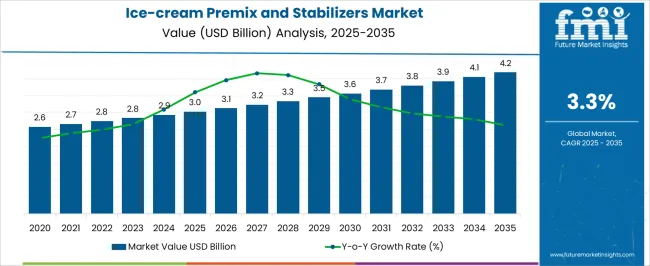
| Metric | Value |
|---|---|
| Ice-cream Premix and Stabilizers Market Estimated Value in (2025 E) | USD 3.0 billion |
| Ice-cream Premix and Stabilizers Market Forecast Value in (2035 F) | USD 4.2 billion |
| Forecast CAGR (2025 to 2035) | 3.3% |
The ice-cream premix and stabilizers market is a key segment of the broader ice-cream and frozen desserts industry. In 2025, premixes and stabilizers account for approximately 18% of the overall ice-cream ingredient market, reflecting growing adoption by commercial producers to enhance texture, creaminess, and shelf life. The broader ice-cream and frozen desserts market is projected to grow at a CAGR of around 2.5–3% during 2025–2035, while premixes and stabilizers slightly outperform this trend with a CAGR of 3.3%, underlining their importance as a value-added ingredient segment. Within the ice-cream ingredients market, premixes and stabilizers hold an estimated 30% share in 2025, with dairy, flavors, and sweeteners comprising the remainder. By 2030, scaling adoption is expected to raise the share to nearly 33%, driven by increased integration into commercial, artisanal, and foodservice applications.
Between 2030 and 2035, consolidation is anticipated as leading suppliers streamline product offerings, expand distribution networks, and establish long-term contracts with manufacturers. By 2035, premixes and stabilizers are projected to account for roughly 35% of the ice cream ingredients segment and approximately 19–20% of the overall frozen desserts market, solidifying their role as a consistent growth driver and key contributor to revenue in the parent market.
The ice-cream premix and stabilizers market is witnessing strong momentum, supported by the expansion of the global frozen desserts sector and rising consumer inclination toward premium-quality ice cream products. Increasing demand for consistent texture, improved shelf life, and enhanced flavor delivery in ice cream has fueled the adoption of specialized premixes and stabilizers. The market benefits from the convenience and efficiency offered by premixes, which streamline manufacturing processes and ensure uniform product quality across large-scale production.
Stabilizers play a critical role in preventing ice crystal formation, maintaining creaminess, and enhancing mouthfeel, thereby meeting evolving sensory expectations. Growth is further reinforced by the rise of artisanal and functional ice cream offerings, where customized blends of premixes and stabilizers cater to niche consumer segments.
Regulatory approvals for a range of stabilizing agents and ongoing product innovations are also supporting expansion. The market is expected to remain resilient due to sustained demand in both retail and foodservice channels, with innovation and formulation versatility driving competitive advantage.
The ice-cream premix and stabilizers market is segmented by type, stabilizers type, application, distribution channels, and geographic regions. By type, ice-cream premix and stabilizers market is divided into Premix and Stabilizer. In terms of stabilizers type, ice-cream premix and stabilizers market is classified into Gelatin, Guar Gum, Locust Bean Gum, Xanthan Gum, Pectin, and Others. Based on application, ice-cream premix and stabilizers market is segmented into Ice Cream, Frozen Yogurt, Sorbet, Gelato, Ice Pops, and Others. By distribution channels, ice-cream premix and stabilizers market is segmented into Supermarkets and Hypermarkets, Convenience Stores, Online Retail, Specialty Stores, and Others. Regionally, the ice-cream premix and stabilizers industry is classified into North America, Latin America, Western Europe, Eastern Europe, Balkan & Baltic Countries, Russia & Belarus, Central Asia, East Asia, South Asia & Pacific, and the Middle East & Africa.
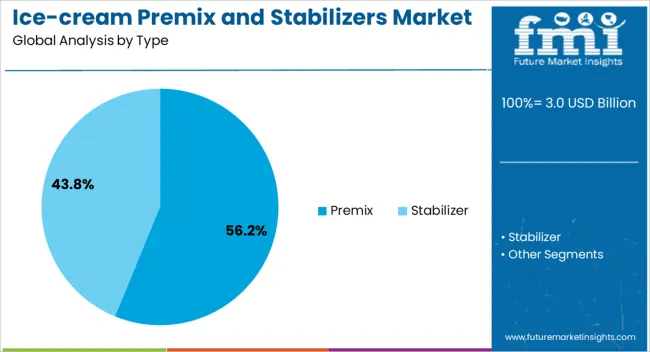
The premix segment leads the market by type, holding approximately 56.2% of the share. This dominance is attributed to the segment’s ability to deliver consistent quality, streamline production, and reduce formulation errors in large-scale manufacturing. Premixes enable producers to incorporate precise ratios of key ingredients, ensuring flavor uniformity and improved operational efficiency.
Their adoption is further driven by the rising demand for time-saving solutions in ice cream manufacturing, especially within industrial and quick-service formats. The growing variety of premix options tailored to different flavor profiles, fat contents, and dietary requirements has also contributed to the segment’s expansion.
With manufacturers increasingly focusing on ready-to-use, customizable solutions to meet consumer demand for innovation, the premix segment is expected to maintain its leading position. The combination of convenience, cost-effectiveness, and scalability continues to reinforce its appeal across both established and emerging markets.
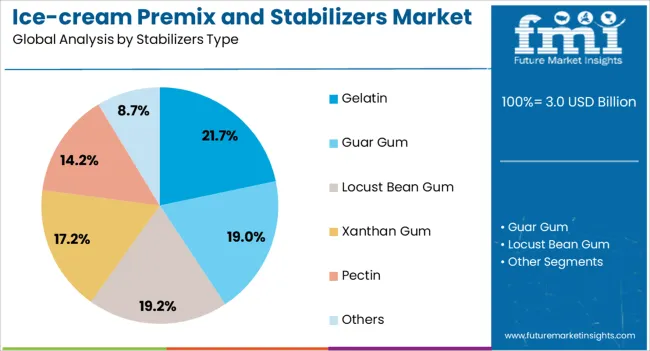
The gelatin segment leads the stabilizers category with around 21.7% of the market share. Its position is supported by gelatin’s proven efficacy in improving ice cream texture, enhancing body, and reducing ice crystal growth during storage. Derived from collagen, gelatin offers functional benefits such as water binding and foam stabilization, which are critical for achieving a smooth and creamy mouthfeel.
The ingredient’s compatibility with other stabilizers and emulsifiers allows manufacturers to create synergistic blends for superior performance. Although alternative stabilizers are gaining traction due to plant-based trends, gelatin continues to hold a strong presence in traditional formulations due to its cost-effectiveness and sensory advantages.
Stable demand from both industrial-scale ice cream production and artisanal applications underpins the segment’s share. Given its functional reliability and versatility, the gelatin segment is expected to remain a key component in stabilizer formulations despite growing diversification in stabilizing agents.
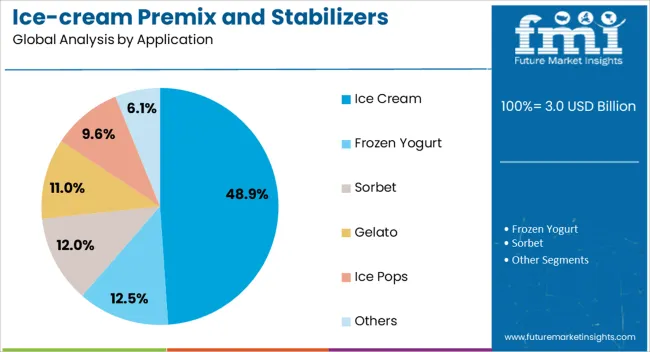
The ice cream segment dominates the application category, capturing approximately 48.9% of the market share. This leadership is driven by the consistent global consumption of ice cream as a mainstream dessert, supported by year-round availability and flavor innovation. Stabilizers and premixes are integral to ice cream production, ensuring uniformity, extended shelf life, and desirable texture across diverse product formats, from premium tubs to novelty sticks.
The segment’s growth is reinforced by rising demand in emerging economies, where increasing disposable incomes and urbanization are expanding the consumer base. Additionally, product diversification, including low-fat, high-protein, and functional ice cream variants, has fueled the need for tailored premix and stabilizer solutions.
The scalability of ice cream production in industrial facilities and the popularity of artisanal brands in local markets further sustain demand. With strong market penetration and continuous innovation in flavor and texture, the ice cream segment is expected to maintain its dominant role in driving the ice cream premix and stabilizers market.
The ice-cream premix and stabilizers market is expanding due to rising demand for high-quality, creamy, and shelf-stable ice-cream products. North America and Europe lead adoption with premium flavors, clean-label preferences, and advanced food safety standards. Asia-Pacific shows rapid growth driven by urbanization, rising disposable income, and increasing frozen dessert consumption. Manufacturers differentiate through texture enhancement, melt resistance, and functional ingredients. Regional differences in dietary preferences, regulatory compliance, and production scale strongly influence product formulation, innovation, and market competitiveness.
Rising consumer demand for frozen desserts is driving the ice-cream premix and stabilizers market. North America and Europe show strong adoption of premium ice-cream with unique flavors, low-fat formulations, and clean-label ingredients, supported by modern retail channels. Asia-Pacific markets, including India, China, and Southeast Asia, are experiencing rapid growth due to urbanization, rising disposable incomes, and expanding retail and foodservice networks. Differences in consumption patterns, flavor preferences, and portion size influence premix composition, stabilizer types, and processing techniques. Leading suppliers provide functional stabilizers that enhance creaminess, prevent ice crystal formation, and maintain shelf life, while regional producers focus on cost-effective, mass-market solutions. The contrast between premium-focused Western markets and volume-driven emerging markets shapes adoption, innovation, and competitive positioning globally.
Innovation in premixes and stabilizers, including natural emulsifiers, fiber-rich blends, and plant-based stabilizers, is accelerating market growth. North America and Europe prioritize clean-label and allergen-free solutions to meet health-conscious consumer preferences. Asia-Pacific markets focus on affordable yet functional formulations that improve texture, melting resistance, and shelf stability. Differences in regulatory frameworks, ingredient availability, and consumer awareness influence formulation strategies. Leading suppliers emphasize high-performance stabilizers, protein-enriched premixes, and advanced functional blends, while regional players focus on cost-efficient, locally sourced ingredients. Product innovation contrasts enable brands to cater to diverse market needs, enhance sensory properties, and strengthen competitiveness across global ice-cream premix and stabilizers markets.
The industrial ice-cream production and modern retail expansion are increasing demand for premixes and stabilizers. North America and Europe rely on large-scale manufacturers supplying supermarkets, convenience stores, and foodservice channels, emphasizing product consistency and shelf-life stability. Asia-Pacific markets, driven by growing urban populations, retail expansion, and fast-food chains, are rapidly scaling up production capacities. Differences in manufacturing scale, distribution infrastructure, and refrigeration availability influence premix formulations, stabilizer selection, and processing methods. Leading suppliers focus on ready-to-use, high-performance blends suitable for large industrial operations, while regional suppliers offer adaptable, cost-efficient products. Industrial production contrasts and retail channel expansion shape adoption, efficiency, and competitiveness across the global ice-cream premix and stabilizers market.
Food safety and regulatory compliance play a critical role in shaping the market. North America and Europe maintain strict guidelines on additive usage, labeling, and ingredient traceability, which in turn influence premix formulation, stabilizer choice, and quality control. Asia-Pacific regulations vary: developed countries adopt international standards, while emerging markets follow flexible local regulations. Differences in inspection frequency, certification requirements, and allowable additive limits impact supplier operations, raw material sourcing, and product labeling. Leading manufacturers provide certified, high-quality premixes and stabilizers, ensuring consistent performance, while regional producers focus on compliance with local standards. Regulatory contrasts drive adoption, product trust, and market competitiveness globally.
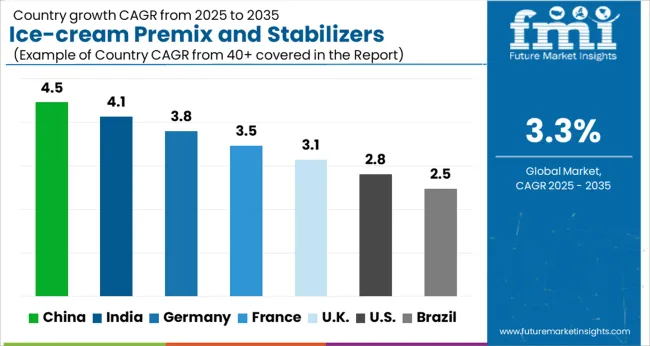
| Countries | CAGR |
|---|---|
| China | 4.5% |
| India | 4.1% |
| Germany | 3.8% |
| France | 3.5% |
| UK | 3.1% |
| USA | 2.8% |
| Brazil | 2.5% |
The global ice-cream premix and stabilizers market is projected to grow at a 3.3% CAGR through 2035, driven by rising demand in frozen dessert manufacturing, dairy processing, and retail segments. Among BRICS nations, China led with 4.5% growth as large-scale production and distribution networks were expanded, while India at 4.1% enhanced supply and processing capacities to meet increasing regional consumption. In the OECD region, Germany at 3.8% maintained consistent output under strict quality and food safety regulations, while the United Kingdom at 3.1% facilitated moderate deployment across commercial and retail outlets. The USA., growing at 2.8%, supported steady adoption in dairy and frozen dessert applications while complying with federal and state-level regulatory frameworks. This report includes insights on 40+ countries; the top countries are shown here for reference.
The ice-cream premix and stabilizers market in China is growing at a 4.5% CAGR, driven by rising demand for frozen desserts and premium ice-cream varieties. Urbanization, higher disposable incomes, and changing consumer tastes are increasing the consumption of ready-to-make ice-cream products. Foodservice outlets, ice-cream parlors, and dessert chains are incorporating stabilized premixes to ensure consistent quality, texture, and shelf-life. Domestic manufacturers are investing in research and development to produce innovative premixes with natural stabilizers and tailored flavor profiles. E-commerce and modern retail channels are improving product accessibility, while food safety regulations ensure compliance with quality standards. Overall, China’s market growth reflects rising urban demand, technological innovation, and consumer preference for high-quality, consistent ice-cream products.
Ice-cream premix and stabilizers market in India is registering a 4.1% CAGR, supported by rising urban consumption of frozen desserts and growth in ice-cream parlors and foodservice chains. Changing lifestyles, higher disposable income, and increasing demand for premium and ready-to-make ice-cream products are key growth factors. Domestic and international manufacturers are providing premixes and stabilizers tailored to local taste preferences and climatic conditions. Distribution through modern retail, supermarkets, and e-commerce platforms enhances availability in tier-one and tier-two cities. Food safety regulations and quality certifications improve consumer trust. The market growth is shaped by urban lifestyle changes, technological innovation in premix formulation, and expansion of the ice-cream foodservice sector.
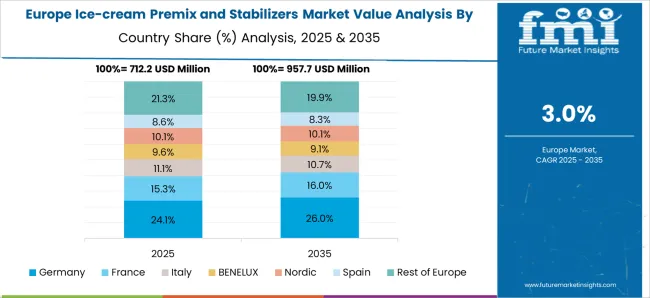
Ice-cream premix and stabilizers market in Germany is growing at a 3.8% CAGR, driven by consumer preference for high-quality, consistent frozen desserts. Foodservice outlets, ice-cream parlors, and specialty dessert shops rely on premixes to ensure uniform texture and extended shelf-life. Manufacturers focus on natural stabilizers, functional ingredients, and innovative formulations to meet evolving consumer demands. Retail and online grocery platforms provide broad accessibility for industrial and commercial buyers. Regulatory standards for food safety and quality drive consistent compliance. Market growth reflects steady demand from urban consumers, innovation in premix formulations, and increasing adoption of sustainable and natural ingredients.
The United Kingdom market is expanding at a 3.1% CAGR, supported by growth in premium and ready-to-make ice-cream consumption. Ice-cream parlors, cafes, and dessert chains adopt stabilized premixes to maintain product consistency and improve shelf-life. Manufacturers are focusing on natural and functional stabilizers to meet health-conscious consumer demands. Distribution through modern retail, specialized food suppliers, and online stores enhances product accessibility. Marketing strategies emphasize product quality, consistency, and ease of preparation. The market reflects moderate growth driven by consumer demand for premium desserts, regulatory standards ensuring food safety, and technological innovation in premix and stabilizer formulations.
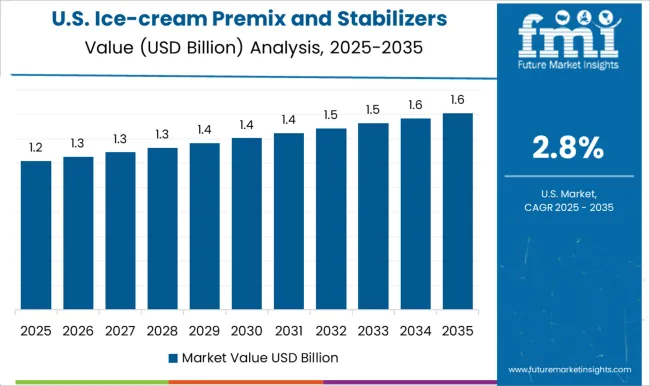
The United States ice-cream premix and stabilizers market is growing at a 2.8% CAGR, supported by steady consumption of frozen desserts and premium ice-cream products. Foodservice establishments, dessert chains, and retail operators adopt premixes to maintain texture, consistency, and extended shelf-life. Manufacturers focus on functional, natural, and innovative stabilizers to meet changing consumer preferences and clean-label trends. Distribution through supermarkets, retail chains, and e-commerce platforms improves accessibility. Regulatory standards ensure product safety and compliance, supporting consumer trust. The USA market reflects moderate growth driven by consistent demand, innovation in premix formulation, and adoption of high-quality, convenient frozen dessert solutions.
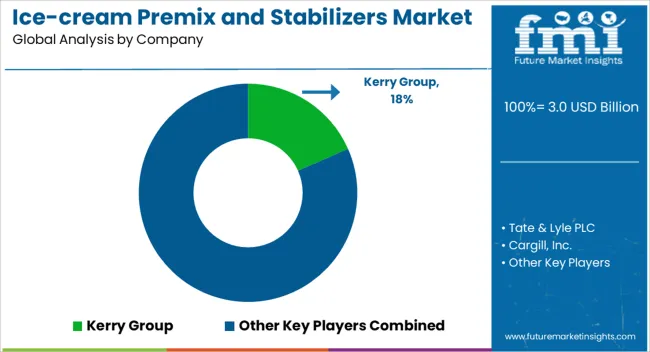
The ice-cream premix and stabilizers market is dominated by a range of prominent suppliers who specialize in delivering innovative solutions to enhance product quality, texture, and shelf life. Companies such as Kerry Group, Tate & Lyle PLC, and Cargill, Inc. are among the leading players in this space, providing comprehensive premixes and stabilizers for both artisanal and industrial ice-cream production. These suppliers focus on developing functional ingredients that improve creaminess, mouthfeel, and overall sensory experience while ensuring consistent quality across large-scale production. Their research-driven approach enables manufacturers to produce ice-cream with the desired texture, stability, and freezing properties, catering to the evolving expectations of consumers globally. Other significant contributors to the market include Palsgaard A/S, DuPont Nutrition & Biosciences, Ingredion Incorporated, and Glanbia Nutritionals, which provide advanced stabilizing systems, emulsifiers, and functional additives. These solutions play a critical role in achieving optimal viscosity, preventing ice crystallization, and maintaining product stability during storage and distribution. By offering customizable solutions tailored to specific formulations, these companies help manufacturers create a wide variety of products such as traditional ice-cream, gelato, frozen yogurt, and soft-serve options. Their expertise ensures compliance with international food safety regulations, clean-label requirements, and the growing demand for natural and plant-based ingredients. Additionally, leading suppliers are actively investing in innovation to address emerging trends, such as low-sugar, lactose-free, and vegan ice cream formulations. This involves developing premixes and stabilizers that deliver high-quality sensory characteristics without compromising taste or texture, supporting manufacturers in meeting changing consumer preferences.
By leveraging cutting-edge technology and formulation expertise, these companies enable ice-cream producers to optimize production efficiency, reduce waste, and enhance product appeal. The competitive landscape is further strengthened by strategic collaborations, global distribution networks, and ongoing R&D initiatives, ensuring that these suppliers remain at the forefront of the ice-cream premix and stabilizers market. The combined capabilities of these industry leaders provide a robust foundation for the growth and expansion of the ice-cream premix and stabilizers market.
| Item | Value |
|---|---|
| Quantitative Units | USD 3.0 Billion |
| Type | Premix and Stabilizer |
| Stabilizers Type | Gelatin, Guar Gum, Locust Bean Gum, Xanthan Gum, Pectin, and Others |
| Application | Ice Cream, Frozen Yogurt, Sorbet, Gelato, Ice Pops, and Others |
| Distribution Channels | Supermarkets and Hypermarkets, Convenience Stores, Online Retail, Specialty Stores, and Others |
| Regions Covered | North America, Europe, Asia-Pacific, Latin America, Middle East & Africa |
| Country Covered | United States, Canada, Germany, France, United Kingdom, China, Japan, India, Brazil, South Africa |
| Key Companies Profiled | Kerry Group, Tate & Lyle PLC, Cargill, Inc., Palsgaard A/S, DuPont Nutrition & Biosciences, Ingredion Incorporated, and Glanbia Nutritionals |
| Additional Attributes | Dollar sales vary by product type, including premixes, stabilizers, and emulsifiers; by application, such as ice cream, frozen desserts, and gelato; by end-use, spanning ice cream manufacturers, dairy processors, and foodservice providers; by region, led by North America, Europe, and Asia-Pacific. Growth is driven by rising ice cream consumption, demand for premium textures, and clean-label ingredients. |
The global ice-cream premix and stabilizers market is estimated to be valued at USD 3.0 billion in 2025.
The market size for the ice-cream premix and stabilizers market is projected to reach USD 4.2 billion by 2035.
The ice-cream premix and stabilizers market is expected to grow at a 3.3% CAGR between 2025 and 2035.
The key product types in ice-cream premix and stabilizers market are premix and stabilizer.
In terms of stabilizers type, gelatin segment to command 21.7% share in the ice-cream premix and stabilizers market in 2025.






Our Research Products

The "Full Research Suite" delivers actionable market intel, deep dives on markets or technologies, so clients act faster, cut risk, and unlock growth.

The Leaderboard benchmarks and ranks top vendors, classifying them as Established Leaders, Leading Challengers, or Disruptors & Challengers.

Locates where complements amplify value and substitutes erode it, forecasting net impact by horizon

We deliver granular, decision-grade intel: market sizing, 5-year forecasts, pricing, adoption, usage, revenue, and operational KPIs—plus competitor tracking, regulation, and value chains—across 60 countries broadly.

Spot the shifts before they hit your P&L. We track inflection points, adoption curves, pricing moves, and ecosystem plays to show where demand is heading, why it is changing, and what to do next across high-growth markets and disruptive tech

Real-time reads of user behavior. We track shifting priorities, perceptions of today’s and next-gen services, and provider experience, then pace how fast tech moves from trial to adoption, blending buyer, consumer, and channel inputs with social signals (#WhySwitch, #UX).

Partner with our analyst team to build a custom report designed around your business priorities. From analysing market trends to assessing competitors or crafting bespoke datasets, we tailor insights to your needs.
Supplier Intelligence
Discovery & Profiling
Capacity & Footprint
Performance & Risk
Compliance & Governance
Commercial Readiness
Who Supplies Whom
Scorecards & Shortlists
Playbooks & Docs
Category Intelligence
Definition & Scope
Demand & Use Cases
Cost Drivers
Market Structure
Supply Chain Map
Trade & Policy
Operating Norms
Deliverables
Buyer Intelligence
Account Basics
Spend & Scope
Procurement Model
Vendor Requirements
Terms & Policies
Entry Strategy
Pain Points & Triggers
Outputs
Pricing Analysis
Benchmarks
Trends
Should-Cost
Indexation
Landed Cost
Commercial Terms
Deliverables
Brand Analysis
Positioning & Value Prop
Share & Presence
Customer Evidence
Go-to-Market
Digital & Reputation
Compliance & Trust
KPIs & Gaps
Outputs
Full Research Suite comprises of:
Market outlook & trends analysis
Interviews & case studies
Strategic recommendations
Vendor profiles & capabilities analysis
5-year forecasts
8 regions and 60+ country-level data splits
Market segment data splits
12 months of continuous data updates
DELIVERED AS:
PDF EXCEL ONLINE
Premix Packaging Machine Market Size and Share Forecast Outlook 2025 to 2035
Premix Bottled Cocktails Market Trends - Growth & Consumer Shifts 2025 to 2035
Premix Bread Flour Market Growth - Trends & Applications 2025 to 2035
Premixed Cocktail Shots Market Growth - Consumer Trends 2024 to 2034
Stabilizers Market
Food Stabilizers Market Size and Share Forecast Outlook 2025 to 2035
Food Premix Market Analysis - Size, Share, and Forecast 2025 to 2035
Beer Stabilizers Market Size and Share Forecast Outlook 2025 to 2035
Food Premix Industry Analysis in USA Growth & Demand Forecast 2025 to 2035
Food Premix Industry Analysis in Middle East - Size and Share Forecast Outlook 2025 to 2035
Feed Premix Market Analysis - Size, Share, & Forecast Outlook 2025 to 2035
Evaluating Food Stabilizers Market Share & Provider Insights
Heat Stabilizers Market Report - Growth & Forecast 2025 to 2035
Meat Stabilizers Blends Market Trends - Source & Function Analysis
Soil Stabilizers Market
Bread Premix Market
Bakery Stabilizers Market Size and Share Forecast Outlook 2025 to 2035
Marine Stabilizers Market Size and Share Forecast Outlook 2025 to 2035
Polymer Stabilizers Market Size and Share Forecast Outlook 2025 to 2035
Vaccine Stabilizers Market Analysis - Size, Share, and Forecast Outlook 2025 to 2035

Thank you!
You will receive an email from our Business Development Manager. Please be sure to check your SPAM/JUNK folder too.
Chat With
MaRIA